You have unweighted tree of $n$ vertices. You have to assign a positive weight to each edge so that the following condition would hold:
- For every two different leaves $v_{1}$ and $v_{2}$ of this tree, bitwise XOR of weights of all edges on the simple path between $v_{1}$ and $v_{2}$ has to be equal to $0$.
Note that you can put very large positive integers (like $10^{(10^{10})}$).
It’s guaranteed that such assignment always exists under given constraints. Now let’s define $f$ as the number of distinct weights in assignment.
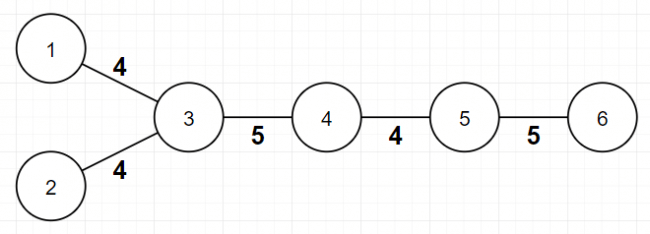
In this example, assignment is valid, because bitwise XOR of all edge weights between every pair of leaves is $0$. $f$ value is $2$ here, because there are $2$ distinct edge weights($4$ and $5$).
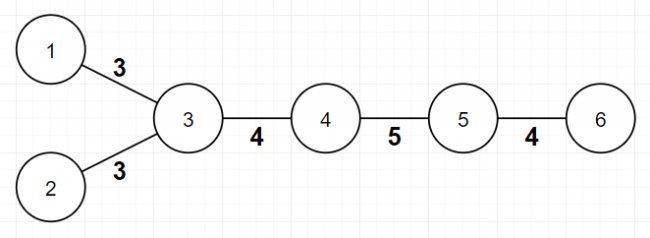
In this example, assignment is invalid, because bitwise XOR of all edge weights between vertex $1$ and vertex $6$ ($3, 4, 5, 4$) is not $0$.
What are the minimum and the maximum possible values of $f$ for the given tree? Find and print both.Input
The first line contains integer $n$ ($3 \le n \le 10^{5}$) — the number of vertices in given tree.
The $i$-th of the next $n-1$ lines contains two integers $a_{i}$ and $b_{i}$ ($1 \le a_{i} \lt b_{i} \le n$) — it means there is an edge between $a_{i}$ and $b_{i}$. It is guaranteed that given graph forms tree of $n$ vertices.Output
Print two integers — the minimum and maximum possible value of $f$ can be made from valid assignment of given tree. Note that it’s always possible to make an assignment under given constraints.Examplesinput
6 1 3 2 3 3 4 4 5 5 6
output
1 4
input
6 1 3 2 3 3 4 4 5 4 6
output
3 3
input
7 1 2 2 7 3 4 4 7 5 6 6 7
output
1 6
Note
In the first example, possible assignments for each minimum and maximum are described in picture below. Of course, there are multiple possible assignments for each minimum and maximum.
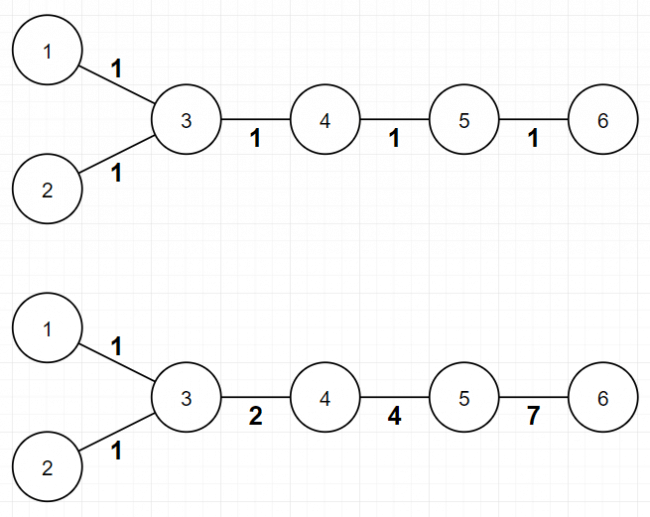
In the second example, possible assignments for each minimum and maximum are described in picture below. The $f$ value of valid assignment of this tree is always $3$.
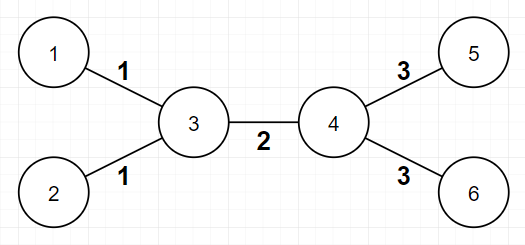
In the third example, possible assignments for each minimum and maximum are described in picture below. Of course, there are multiple possible assignments for each minimum and maximum.
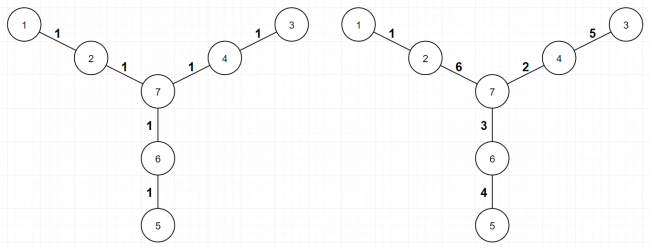
Solution:
#include <bits/stdc++.h>
using namespace std;
template <typename T>
class graph {
public:
struct edge {
int from;
int to;
T cost;
};
vector<edge> edges;
vector<vector<int>> g;
int n;
graph(int _n) : n(_n) {
g.resize(n);
}
virtual int add(int from, int to, T cost) = 0;
};
template <typename T>
class forest : public graph<T> {
public:
using graph<T>::edges;
using graph<T>::g;
using graph<T>::n;
forest(int _n) : graph<T>(_n) {
}
int add(int from, int to, T cost = 1) {
assert(0 <= from && from < n && 0 <= to && to < n);
int id = (int) edges.size();
assert(id < n - 1);
g[from].push_back(id);
g[to].push_back(id);
edges.push_back({from, to, cost});
return id;
}
};
template <typename T>
class dfs_forest : public forest<T> {
public:
using forest<T>::edges;
using forest<T>::g;
using forest<T>::n;
vector<int> pv;
vector<int> pe;
vector<int> order;
vector<int> pos;
vector<int> end;
vector<int> sz;
vector<int> root;
vector<int> depth;
vector<T> dist;
dfs_forest(int _n) : forest<T>(_n) {
}
void init() {
pv = vector<int>(n, -1);
pe = vector<int>(n, -1);
order.clear();
pos = vector<int>(n, -1);
end = vector<int>(n, -1);
sz = vector<int>(n, 0);
root = vector<int>(n, -1);
depth = vector<int>(n, -1);
dist = vector<T>(n);
}
void clear() {
pv.clear();
pe.clear();
order.clear();
pos.clear();
end.clear();
sz.clear();
root.clear();
depth.clear();
dist.clear();
}
private:
void do_dfs(int v) {
pos[v] = (int) order.size();
order.push_back(v);
sz[v] = 1;
for (int id : g[v]) {
if (id == pe[v]) {
continue;
}
auto &e = edges[id];
int to = e.from ^ e.to ^ v;
depth[to] = depth[v] + 1;
dist[to] = dist[v] + e.cost;
pv[to] = v;
pe[to] = id;
root[to] = (root[v] != -1 ? root[v] : to);
do_dfs(to);
sz[v] += sz[to];
}
end[v] = (int) order.size() - 1;
}
void do_dfs_from(int v) {
depth[v] = 0;
dist[v] = T{};
root[v] = v;
pv[v] = pe[v] = -1;
do_dfs(v);
}
public:
void dfs(int v, bool clear_order = true) {
if (pv.empty()) {
init();
} else {
if (clear_order) {
order.clear();
}
}
do_dfs_from(v);
}
void dfs_all() {
init();
for (int v = 0; v < n; v++) {
if (depth[v] == -1) {
do_dfs_from(v);
}
}
assert((int) order.size() == n);
}
};
int main() {
ios::sync_with_stdio(false);
cin.tie(0);
int n;
cin >> n;
dfs_forest<int> g(n);
for (int i = 0; i < n - 1; i++) {
int x, y;
cin >> x >> y;
--x; --y;
g.add(x, y);
}
int root = 0;
while (g.g[root].size() < 2) {
++root;
}
g.dfs(root);
vector<int> has(2, 0);
for (int i = 0; i < n; i++) {
if (g.g[i].size() == 1) {
has[g.depth[i] % 2] += 1;
}
}
cout << ((has[0] && has[1]) ? 3 : 1) << " ";
set<pair<int, int>> s;
for (auto& e : g.edges) {
int x = e.from;
int y = e.to;
x = (g.g[x].size() == 1 ? -1 : x);
y = (g.g[y].size() == 1 ? -1 : y);
s.emplace(min(x, y), max(x, y));
}
cout << s.size() << '\n';
return 0;
}

